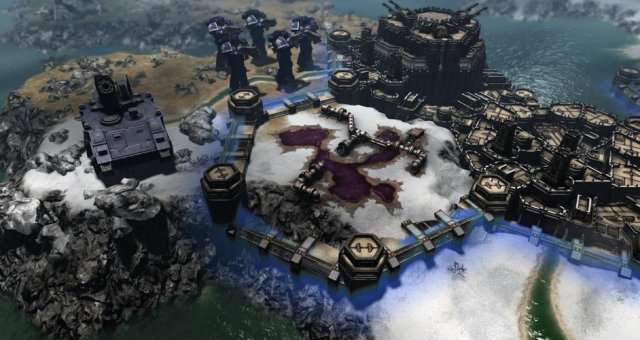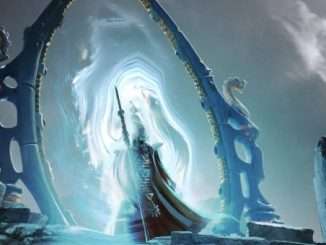
This is a short guide containing a few ideas for single-player beginners. It’s basically what I wish I’d known myself before I started playing.
Introduction
This guide has two parts.
In Part A, I make some general observations about various aspects of the game.
In part B, I outline some of the features of the playable factions, and suggest research approaches for each.
A. General Observations on Gameplay
1. Quests
The ingame quests and the Lord of Skulls option are challenging to say the least. It might be worth starting with those options disabled (uncheck ‘parameters’ advanced and DLC when setting up a new game) to avoid unnecessary annoyance whie you are still getting to grips with the basics of the game.
2. Loyalty
Always keep an eye on your cities’ loyalty (the red flag resource) and don’t let it drop below 0 or your empire’s productivity will quickly grind to a standstill. Each faction has a building that specifically increases loyalty.
3. Production and Base Growth
With all the fighting going on, it’s easy to concentrate on military production and overlook other things. You start with one labour building, and one infantry building; the machine building, the hero building and the airport have to be researched. If you find youself needing a lot of, say, infantry, it may well be worth building one or even two extra infantry buildings in the same base to speed up production. This is particularly true later on when 3 airports will enable you to spam planes in great numbers.The labour building can also be duplicated to speed up tile acquisition and base development – sacrificing a bit of time early on for much faster growth later.
4. Every game is different
A lot depends on where you start – what bonuses the tiles provide etc. and where you are placed strategically. If you get crushed quickly by an AI player, don’t lose hope. This happened to me in my 5th or 6th game, after I’d already won several times – that’s just how things are sometimes. It may even be worth setting one of the AI players as an ally (available when setting up a new game) to give yourself a bit less pressure at the start., and also to see how the AI handles strategy and tactics.
5. Every game is the same
- (a) The independent (grey) units are super aggressive. When exploring expect the worst and either reconnoitre in force, or use only units you can afford to lose.
- (b) Terrain, particularly forests, is hugely important. You can rack up easy kills by setting up your forces to trap opponents unawares. P35, heading 4.1 is by far the most important point in the whole game manual. Also watch out for obstacles such as cliffs and escarpments which can greatly effect movement.
- (c) Why can’t I start a new base? There are restrictions on Space Marine and Necron bases, discussed below. However, in addition to these, you must have enough resources! The price gets higher the more bases you settle. But if you want to settle, and can’t, check you are not too close to another base, and have enough resources.
B. Choosing a Faction and Basic Tier by Tier Research
I have played Space Marines, Necrons, and the Guard (Astra Militarum, or whatever). I have no advice to give regarding Orks. The game requires you to research two techs (out of 5 or 6) at each tier, before moving on to the next tier. As the really powerful units come later on, it’s worth considering how to get to higher tiers fastest with the best research. Other research can also be very useful, and there is not only one way to go about it!
Each type of army has a main purchase cost (what it costs to buy units etc.) and a main support cost (what it costs to maintain those units). It’s helpful to know what these are when deciding how to develop your base tiles.
B1. Space Marines (SM)
The SM are only allowed one base – (Space Venice!) – so the above observations on Production and Base Growth are particularly important. The SM have the ability to drop fortified outposts on any visible tile once every 10 turns, which can be a useful situational ability at times.
Must-have units: Devastator Space Marines, Apothecaries.
Why? Devastators have a huge damage attack when they have not moved, but they are squishy, so you want something in front, namely a regular marine. The Apothecaries provide the necessary healing ability. Unfortunately they arrive quite late, so be prepared to churn out a lot of basic SMs as cannon fodder meanwhile.
The SM’s basic weapon is the bolter.
- Main Purchase Cost: Requisitions
- Main Support Cost: Requisitions, Energy
Core research tree.
- Tier 1 Armory, Tactical Doctrine
- Tier 2 Dormitories, Krak Grenade
- Tier 3 Chapel, Devastator Space Marines
- Tier 4 Orbital Relay, Predator
- Tier 5 Extra Infantry Armour, Thunderfire Cannon
- Tier 6 Apothecaries, Bolter Drill
Note that the Thunderfire Cannon can repair machines and clear tiles as well.
B2. Necrons (NK)
The NK can only build bases on ‘tomb tiles’, which have a green swirly effect on them. The Canoptek Spyder is the ‘settler’ unit.
Must-have units:Tomb Blades (early) Canoptek Spyder, Monolith (later).
Why? Tomb Blades have great movement and a spectacular melee-range attack but you need to wipe out the enemy on first contact, as they are easily killed. Build a squad of Tomb Blades and send them off to explore. or hold strategic bits of forest. Just bear in mind that anything they can’t kill straight away, will almost certainly be able to kill them on its own turn. As stronger units emerge, the Monolith is your friend. A huge attack with its Gauss Flux Arc (note: this needs to be selected each turn for some reason), and huge health to match. The Spyder is a support/settler unit but it has a respectable melee attack and it can also repair machines (the Monolith!) once that tech is researched. Plus it can spawn swarms of scarabs every 5 turns which are fast, lethal and expendable.
The NK’s basic weapon is Gauss.
- Main Purchase Cost: Energy
- Main Support Cost: Ore
- Tier 1 Core Refinements, Hypostyle Temple
- Tier 2 Canoptek Spyder, Shelter
- Tier 3 Baroque Shrine, Scarab Hive
- Tier 4 Atomic Flayers, Fabricator Claw Array
- Tier 5 Extra Infantry Armour, Lord’s Command
- Tier 6 Doomsday Ark, Cryptex Datastyles
- Tier 7 Monolith, Nameless Causeway (for Doom Scythe in Tier 8)
There are research options to improve Tomb Blades, if desired, but returns do diminish nevertheless.
B3. Astra Militarum (AM – the Guard)
AM don’t have any building restrictions. The game will offer tile recommendations (the white tiles) within range, but they are optional.
The AM’s basic weapon is the laser.
Must-have units: Enginseer, Basilisk, tanks.
Why? The Enginseer is the settler unit, and can also repair machines and clear tiles of forest etc. As a fighter it’s not in the same league as either the Canoptek Spyder or the Thunderfire Cannon, but nobody’s perfect. Last but by no means least the Enginseer can acquire the ability to build the Imperial Bastion, a very useful fixed defence. The Basilisk has an amazing range of 6 tiles, from which it can make innumberable kills. The Tank Commander is an early powerful unit which can hunt with a Leman Rus pack searching for targets for the basilisks to finish off.
- Main Purchase Cost: Food/Ore
- Main Support Cost: Food/Ore
- Tier 1 Manufactorium, Shrine of the Aquila
- Tier 2 Cult Mechanicus, Medi-Pak
- Tier 3 Heavy Weapon Squad, Tank Commander
- Tier 4 Basilisk, Hotshot Powerpaks
- Tier 5 Imperial Bastion, Leman Rus Tank
Again, other routes are also possible, e.g. levelling up grenades, producing psykers, if desired.
B4. Orks
The Orks basic weapon is melee.
Must-have units: Boyz, Meks, Battlewagon, Dakkajet
Why? Boyz are the basic infantry unit, but they remain effective for many turns. Meks (the ‘settler’ unit) have 2 functions: settling new bases – and Ork urban sprawl is a good thing – and later on repairing machines. Continuous build these units at the start. As the Boyz begin to fade, switch to building battlewagons; they are tough but require large numbers until their damage is upgraded. The keystone unit is the Dakkajet whch doesn’t require an airport. 3 or 4 are quite capable of taking out a base on a couple of turns.
- Main Purchase Cost: Food/Ore/Energy
- Main Support Cost: Food/Ore/Energy/Influence
Orks seem to have more loyalty problems than most, and they have a variety of cost requirements. It’s particularly useful to get a second labour building (Scrap Shedz) in your bases early so that shortfalls can be addressed promptly. Other than that, spam spam, spam, units and apply fungus to your base tiles when you are waitig for other resources, as it heals your garrisoned units faster.
- Tier 1 Kult ov Speed, Orchid Fungus
- Tier 2 Grotz Homs, Mek Boys Yard
- Tier 3 Eavy Armor, Fighting Pitz
- Tier 4 Bigga Choppas, Scrap Shedz
- Tier 5 Battlewagon, Red Paint Job
- Tier 6 Battlewagon Big Shootas, Freaking Rooms
- Tier 7 Dakkajet, Extra Vehicle Armor
There is a different route where you can build Warbosses and heal them with Painboyz.



Be the first to comment